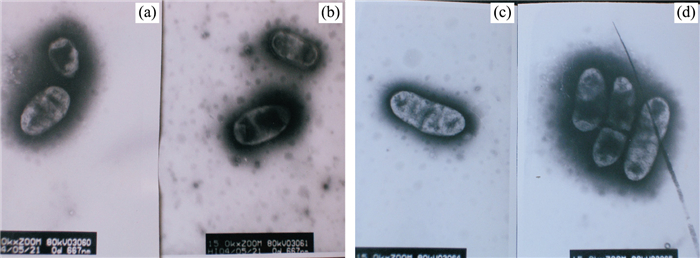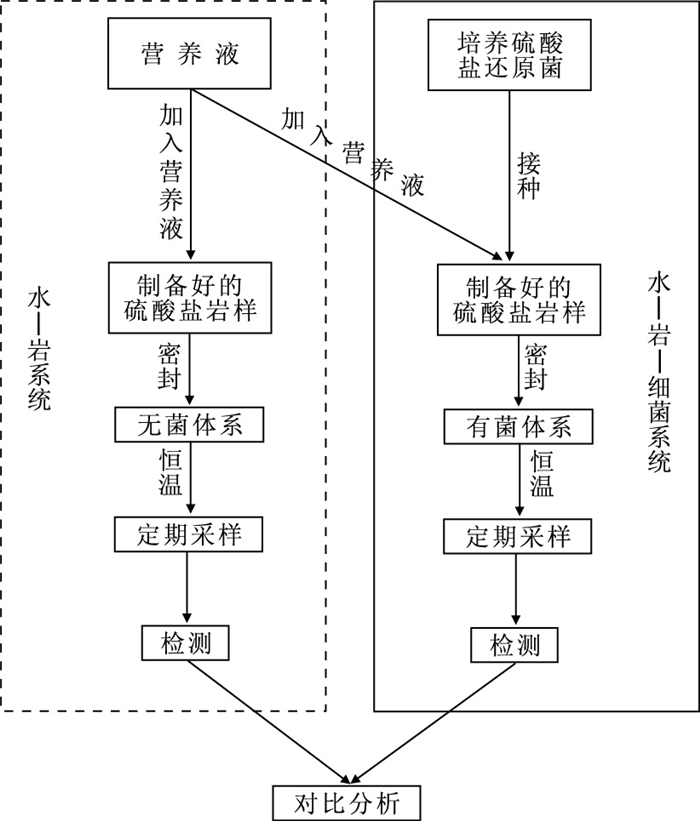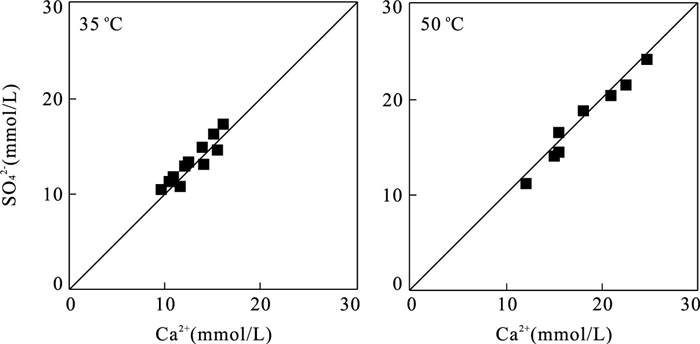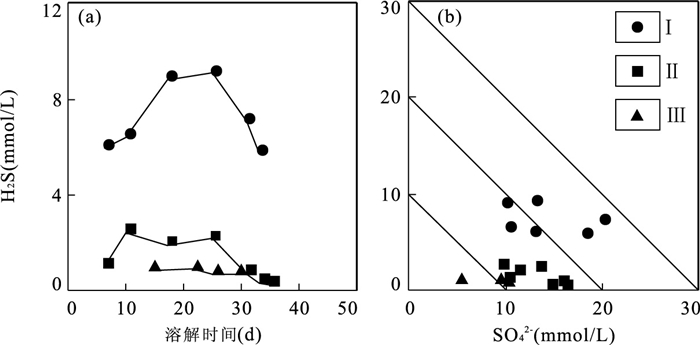Bacterial Mechanism of the Development of Sulfate Karst in Burial Environment
-
摘要: 针对我国广泛分布的碳酸盐-硫酸盐岩混合建造,选择其中的硫酸盐岩作为研究对象,通过室内水-岩和水-岩-细菌两个封闭系统的硫酸盐岩溶蚀模拟实验,模拟了细菌数、温度、时间等因素对反应系统水化学组分的影响,研究了两个系统内的地球化学作用.结果表明,水-岩系统内发生的是硫酸盐岩溶解作用;水-岩-细菌系统内发生了细菌硫酸盐还原作用和细菌硫酸盐还原驱动的硫酸盐岩溶解作用,导致埋藏环境硫酸盐岩岩溶的发育,进而增强了与硫酸盐岩共生的碳酸盐岩的渗透性.研究成果开拓了油气储层古岩溶研究的新思路.Abstract: The present work is designed to simulate the dissolution of sulphate rock under various conditions of different bacterial cell numbers, temperatures and reaction times both in water-rock and water-rock-bacteria systems by laboratory experiment. The results show that chemical dissolution of sulphate rock is dominated in water-rock system, while bacterial sulphate reduction process and the dissolution of sulphate rock driven by bacterial sulphate reduction are dominated in water-rock-bacteria system. The dissolution of sulphate rock driven by bacterial sulphate reduction resultes in the formation of sulphate karst, which enhances the permeability of carbonate rock coexisted with sulphate rock. The research is an insight into biokarst, which provides a new perspective for the field of petroleum geology.
-
表 1 硫酸盐岩化学组成(%)
Table 1. Chemical compositions of the sulfate rock
K2O Na2O CaO MgO SiO2 Al2O3 TiO2 TFe2O3 MnO P2O5 SO3 烧失量 酸不溶物 H2O+ H2O- 0.022 0.0045 32.51 0.31 0.17 0.11 0.007 0.093 0.0015 0.01 46.25 21.28 0.23 20.24 0.05 注:国土资源部河北省中心实验室完成测试. 表 2 硫酸盐岩中矿物成分及其含量
Table 2. Components and contents of minerals in the sulfate rock
矿物名称 占岩样(%) 占硫酸盐矿物(%) 石膏 95.85 96.93 半水石膏 3.03 3.07 表 3 水-岩-细菌反应系统的物理、化学参数
Table 3. Physical and chemical composition of water measured in the water-rock-bacteria system
反应时间(d) 0.5%菌液(35℃) 5%菌液(35℃) 5%菌液(50℃)
ORP
(mV)
Ca2+
(mmol/L)
SO4 2-
(mmol/L)
Ca2+/
SO4 2-
H2S
(mmol/L)
H2S/
SO4 2-
Ca2+
(mmol/L)
SO4 2-
(mmol/L)
Ca2+/
SO4 2-
H2S
(mmol/L)
H2S/
SO4 2-
Ca2+
(mmol/L)
SO4 2-
(mmol/L)
Ca2+/
SO4 2-
H2S
(mmol/L)
H2S/
SO4 2-4 -288.9 7.81 3.91 2.00 5 -297.4 4.15 6.84 0.61 6 7.33 5.86 1.25 6.04 10.01 0.60 0.95 0.09 10.62 12.48 0.85 5.90 0.47 10 9.76 9.37 1.04 2.41 0.26 12.87 10.16 1.27 6.36 0.63 11 -341.2 9.28 8.06 1.15 13 8.89 9.66 0.92 13.52 11.05 1.22 14 -360.0 10.99 9.52 1.15 0.85 0.09 17 11.88 11.07 1.07 1.84 0.17 14.50 9.67 1.50 8.76 0.91 18 11.72 9.03 1.30 21 11.38 10.24 1.11 14.40 9.12 1.58 21.5 -360.7 7.33 5.47 1.34 0.94 0.17 25 -346.4 11.96 10.35 1.16 0.64 0.06 11.53 13.27 0.87 2.15 0.16 17.13 12.89 1.33 9.06 0.70 29 -396.2 0.70 31 15.28 15.52 0.98 0.71 0.05 25.42 19.89 1.28 7.09 0.36 33 -393.1 14.27 14.49 0.98 0.31 0.02 23.59 18.06 1.31 5.72 0.32 35 13.25 16.01 0.83 0.26 0.02 注:国土资源部水文地质环境地质专业测试中心完成了化学组分的测试. -
Aharon, P., Fu, B., 2000. Microbial sulfate reduction rates and sulfur and oxygen isotope fractionations at oil and gas seeps in deepwater Gulf of Mexico. Geochimica et Cosmochimica Acta, 64(2): 233-246. doi: 10.1016/S0016-7037(99)00292-6 Andrejchuk, V.N., Klimchouk, A.B., 2001. Geomicrobiology and redox geochemistry of the karstified Miocene gypsum aquifer, western Ukraine: the study from Zoloushka cave. Geomicrobiology Journal, 18(3): 275-295. doi: 10.1080/01490450152467796 Barton, L.L., 1995. Characterstics and activities of sulfate-reducing bacteria. In: Barton, L.L., ed., Sulfate-reducing bacteria, biotechnology handbooks 8. Plenum Press, New York. Baumgartner, L.K., Reid, R.P., Dupraz, C., et al., 2006. Sulfate reducing bacteria in microbial mats: changing paradigms, new discoveries. Sedimentary Geology, 185: 131-145. doi: 10.1016/j.sedgeo.2005.12.008 Bolliger, C., Schroth, M.H., Bernasconi, S.M., 2001. Sulfur isotope fractionation during microbial sulfate reduction by toluene degrading bacteria. Geochimica Cosmochimica Acta, 65(19): 3289-3298. doi: 10.1016/S0016-7037(01)00671-8 Cai, C.F., Ma, Z.F., Yang, X.Z., 1998. Secondary alteration of trapped oil and natural gas. China Offshore Oil and Gas (Geology), 12(2): 122-126 (in Chinese with English abstract). http://en.cnki.com.cn/Article_en/CJFDTOTAL-ZHSD199802014.htm He, S., Yang, Z., He, Z.L., et al., 2009. Mechanism of carbonate cementation and secondary dissolution porosity formation in deep-burial sandstones near the top overpressured surface in central part of Junggar basin. Earth Science—Journal of China University of Geoscience, 34(5): 759-768 (in Chinese with English abstract). doi: 10.3799/dqkx.2009.084 He, Y.L., 1998. Anaero biological treatment of wastewater. China Light Industry Press, Beijing (in Chinese). Hill, C.A., 1995. H2S-related porosity and sulfuric acid oil-field karst. In: Budd, D.A., Saller, A.H., Harris, P.M., eds., Unconformities and porosity in carbonate strata. American Association Petroleum Geol. Memoir, 63: 301-306. Hill, C.A., 2000. Overview of the geologic history of cave development in the Guadalupe Mountains, New Mexico. Journal of Cave and Karst Studies, 62(2): 60-71. http://vvvvvv.caves.org/pub/journal/PDF/V62/v62n2-Hill.pdf Hose, L.D., Palmer, A.N., Palmer, M.V., et al., 2000. Microbiology and geochemistry in a hydrogen-sulphide rich karst environment. Chemical Geology, 169(3-4): 399-423. doi: 10.1016/S0009-2541(00)00217-5 Huang, S.J., Qing, H.R., Hu, Z.W., et al., 2007. Influence of sulfate reduction on diagenesis of Feixianguan carbonate in Triassic, NE Sichuan basin of China. Acta Sedimentologica Sinica, 25(6): 815-824 (in Chinese with English abstract). Huang, S.J., Yang, J.J., Zhang, W.Z., et al., 1996. Effects of gypsum (or anhydrite) on dissolution of dolomite under different temperatures and pressures of epigenesis and burial diagenesis. Acta Sedimentologica Sinica, 14(1): 103-109 (in Chinese with English abstract). http://www.cnki.com.cn/Article/CJFDTotal-CJXB601.011.htm Klimchouk, A.B., 1997. The role of karst in the genesis of sulfur deposits, Pre-Carpathian region, Ukraine. Environmental Geology. 31(1-2): 1-20. doi: 10.1007/s002540050158 Klimchouk, A.B., 2000. The dissolution and conversion of gypsum and anhydrite. In: Klimchouk, A.B., Ford, D.C., Palmer, A.N., et al., eds., Speleogenesis. National Speleological Society Huntsville, Alabama, 160-168. Leonov, A.V., Chicherina, O.V., 2008. Sulfate reduction in natural water bodies. 1. The effect of environmental factors and the measured rates of the process. Water Resources, 35(4): 417-434. doi: 10.1134/S0097807808040052 Li, L.H., Dang, Z., Li, S.H., 2005. Domesticated cultivation of sulfate-reducing bacteria and its efficiency of sulfate removal. Bulletin of Mineralogy, Petrology and Geochemistry, 24(2): 144-147 (in Chinese with English abstract). http://www.researchgate.net/publication/289080520_Domesticated_cultivation_of_sulfate-reducing_bacteria_and_its_efficiency_of_sulfate_removal Li, X.R., Shen, D.Z., 1999. Ecological characters and application of sulfate-reducing bacteria. Chinese Journal of Applied & Environmental Biology, 5 (Suppl. ): 10-13 (in Chinese with English abstract). http://en.cnki.com.cn/Article_en/CJFDTOTAL-YYHS1999S1002.htm Lu, Y.R., Zhang, F.E., Yan, B.R., et al., 2002. Mechanism of karst development in sulphate rock and its main geo-environmental impacts. Acta Geoscientia Sinica, 23 (1): 1-6 (in Chinese with English abstract). http://en.cnki.com.cn/Article_en/CJFDTOTAL-DQXB200201000.htm Palmer, A.N., Palmer, M.V., 2004. Sulfate-carbonate interactions in the development of karst. Northeastern Geology and Environmental Sciences, 26(1-2): 93-106. http://www.researchgate.net/publication/285854312_Sulfate-carbonate_interactions_in_the_development_of_karst Paskauskas, R., Kucinskiene, A., Zvikas, A., 2005. Sulfate-reducing bacteria in gypsum karst lakes of northern Lithuania. Microbiology, 74(6): 715-721. doi: 10.1007/s11021-005-0129 Postatg, J.R., 1984. The sulphate reducing bacteria. Cambridge University Press, UK. Raines, M.A., Dewers, T.A., 1997. Mixed transport / reaction control of gypsum dissolution kinetics in aqueous solutions and initiation of gypsum karst. Chemical Geology, 140(1): 29-48. doi: 10.1016/S0009-2541(97)00018-1 Wan, H.Q., Su, S.J., Zhu, J.H., et al., 2004. Study on the factors affecting growth of the sulphate-reducing bacteria and its biological desulfurization capability. Journal of Chemical Engineering of Chinese Universities, 18(2): 218-223 (in Chinese with English abstract). http://en.cnki.com.cn/Article_en/CJFDTOTAL-GXHX200402015.htm Xiang, T.S., Wan, J.Y., Cai, C.F., 2004. Treatment of crude oils using sulphate-reducing bacteria H2S formation. Natural Gas Geoscience, 15(2): 171-183 (in Chinese with English abstract). http://www.nggs.ac.cn/EN/Y2004/V15/I2/171 Zanbak, C., Arthur, R.C., 1986. Geochemical and engineering aspects of anhydrite-gypsum phase transitions. Bulletin of Association of Engineering Geology, 23(4): 419-433. http://www.onacademic.com/detail/journal_1000039701294410_5142.html Zhang, X.L., Chen, Z.X., Liu, H.H., et al., 2000. Effect of environment factors on the growth of sulfate-reducing bacteria. Journal of Chinese Society for Corrosion and Protection, 20(4): 224-229 (in Chinese with English abstract). http://en.cnki.com.cn/Article_en/CJFDTOTAL-ZGFF200004005.htm Zhang, X.L., Liu, H.H., Chen, K.X., et al., 1999. The study of growing regulation of sulfate-reducing bacteria. Journal of Northwest University (Natural Science Edition), 29(5): 397-402 (in Chinese with English abstract). http://en.cnki.com.cn/Article_en/CJFDTOTAL-XBDZ199905008.htm Zheng, C.B., Wang, F.Y., Jia, S.Y., 1997. Karst rock of weathered crust of Ordovician and its karstification mode in Central Shan'ganning basin. Carsologica Sinica, 16(4): 352-359 (in Chinese with English abstract). http://www.researchgate.net/publication/292766277_Karst_rock_of_weathered_crust_of_Ordovician_and_its_karstification_mode_in_Central_Shaanganning_basin Zheng, S.M., Yan, W.M., Qian, X.M., 1983. Autotrphic microorganism. Science Press, Beijing (in Chinese). 蔡春芳, 马振芳, 杨贤州, 1998. 圈闭中油气的次生蚀变作用. 中国海上油气(地质), 12(2): 122-126. https://www.cnki.com.cn/Article/CJFDTOTAL-ZHSD199802014.htm 何生, 杨智, 何治亮, 等, 2009. 准噶尔盆地腹部超压顶面附近深层砂岩碳酸盐胶结作用和次生溶蚀孔隙形成机理. 地球科学——中国地质大学学报, 34(5): 759-768. https://www.cnki.com.cn/Article/CJFDTOTAL-DQKX200905008.htm 贺延龄, 1998. 废水的厌氧生物处理. 北京: 中国轻工业出版社. 黄思静, Qing, H.R., 胡作维, 等, 2007. 四川盆地东北部三叠系飞仙关组硫酸盐还原作用对碳酸盐成岩作用的影响. 沉积学报, 25(6): 815-824. doi: 10.3969/j.issn.1000-0550.2007.06.001 黄思静, 杨俊杰, 张文正, 等, 1996. 石膏对白云岩溶解影响的实验模拟研究. 沉积学报, 14(1): 103-109. https://www.cnki.com.cn/Article/CJFDTOTAL-CJXB601.011.htm 李连华, 党志, 李舒衡, 2005. 硫酸盐还原菌的驯化培养及脱硫性能研究. 矿物岩石地球化学通报, 24(2): 144-147. https://www.cnki.com.cn/Article/CJFDTOTAL-KYDH200502012.htm 李新荣, 沈德中, 1999. 硫酸盐还原菌的生态特性及其应用. 应用与环境生物学报, 5(增刊): 10-13. https://www.cnki.com.cn/Article/CJFDTOTAL-YYHS1999S1002.htm 卢耀如, 张凤娥, 阎葆瑞, 等, 2002. 硫酸盐岩岩溶发育机理与有关地质环境效应. 地球学报, 23(1): 1-6. https://www.cnki.com.cn/Article/CJFDTOTAL-DQXB200201000.htm 万海清, 苏仕军, 朱家骅, 等, 2004. 硫酸盐还原菌的生长影响因子及脱硫性能的研究. 高校化学工程学报, 18(2): 218-223. doi: 10.3321/j.issn:1003-9015.2004.02.016 向廷生, 万家云, 蔡春芳, 2004. 硫酸盐还原菌对原油的降解作用和硫化氢的生成. 天然气地球科学, 15(2): 171-183. https://www.cnki.com.cn/Article/CJFDTOTAL-TDKX200402015.htm 张小里, 陈志昕, 刘海洪, 等, 2000. 环境因素对硫酸盐还原菌生长的影响. 中国腐蚀与防护学报, 20(4): 224-229. https://www.cnki.com.cn/Article/CJFDTOTAL-ZGFF200004005.htm 张小里, 刘海洪, 陈开勋, 等, 1999. 硫酸盐还原菌生长规律的研究. 西北大学学报(自然科学版), 29(5): 397-402. https://www.cnki.com.cn/Article/CJFDTOTAL-XBDZ199905008.htm 郑聪斌, 王飞雁, 贾疏源, 1997. 陕甘宁盆地中部奥陶系风化壳岩溶岩及岩溶相模式. 中国岩溶, 16(4): 352-359. https://www.cnki.com.cn/Article/CJFDTOTAL-ZGYR704.008.htm 郑士民, 颜望明, 钱新民, 1983. 自养微生物. 北京: 科学出版社. -










 下载:
下载:





